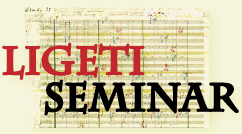7) 1985-90; Chaos, Detuning the World
The Piano Concerto and the second book of etudes, influence of chaos theory and African music.
For week 8
Read
Paul Griffiths, Towards Mode/Meme, Modern Music and After (Oxford: Oxford University Press, 2010).
György Ligeti, Liner notes to CD SK 62308, Ligeti edition 3: Piano works (trans. A. McVoy and D. Feurzeig) (1997)
Alex Ross, "Ligeti Split," The New Yorker (May 28, 2001)
Martin Scherzinger, "György Ligeti and the Aka Pygmies Project," Contemporary Music Review 25/3 (2006), 227–62.
Charles Wilson, "György Ligeti and the Rhetoric of Autonomy," twentieth.century music 1/1 (2004), 5–28.
Listen
Radio 7: 1985-1990; Chaos; Detuning the World
Analyze for May 21
Passacaglia ungherese for harpsichord (1978)
Questions here as Word doc. As pdf
Final assignment for May 28
Choose one of the following piano etudes and discuss it in approximately 300-500 words; touch on pitch/harmonic structure, rhythm, and any other features you find notable: First book, Nos. 2, 3, 4, 5; Second book, Nos. 10, 11, 12, 13, 14; or anything from the third book.
Further Reading
György Ligeti and Dermot Clinch, "From kitchen utensils to music as the love of food," New Statesman 125:4314 (1996), 41.
György Ligeti and Benoît Delbecq, "György Ligeti interviewed by Benoît Delbecq," Jazz Magazine 484 (1998)
Jean Christensen and György Ligeti, "An art without ideology," trans. Jean Christensen and Anders Beyer, in The Voice of Music: Conversations with Composers of Our Time, Anders Beyer, (ed.) (Aldershot: Ashgate 2000), 1–14.
Paul Griffiths and György Ligeti, Interview in The Substance of Things Heard: writings about music (Rochester: University of Rochester Press 2005), 188–19.
Pierre Gervasoni, "Interview with György Ligeti," Le Monde (27 Sept, 1997)
Amy Bauer, “Canon as agent of revelation in the music of Ligeti,” Contemporary Music and Spirituality, Sander van Maas and Robert Sholl, eds. (Aldershot, UK: Ashgate, 2016)
Wolfgang Marx, "How I wonder what you're at!’—Sketch Studies of Ligeti's Nonsense Madrigals," Contemporary Music Review 31:2-3 (2012), 135-148.
Florian Scheding, "Where Is the Holocaust in All This? György Ligeti and the Dialectics of Life and Work," in Dislocated Memories: Jews, Music, and Postwar German Culture, ed. Tina Frühauf and Lily E.Hirsch (New York: Oxford University Press, 2014), 205–21.
Michael D. Searby, "To the Future or the Past? Ligeti’s Stylistic Eclecticism in His Hamburg Concerto," Contemporary Music Review 31/2-3 (2012), 239–46.
Bianca Tiplea Temes, "Ligeti’s String Quartet Music: From the Published Works to the New Discoveries at the Paul Sacher Foundation," in Latest Advances in Acoustics and Music: Proceedings of the 13th WSEAS International Conference on Acoustics & Music: Theory &Applications (AMTA '12) (WSEAS Press, 2012), 183–88.
Amy Bauer, "Singing Wolves and Dreaming Apples: The Cosmopolitan Imagination in Ligeti’s Weöres Songs," Ars Lyrica 21 2012 1–39.
Taylor, Stephen Andrew, "Hemiola, Maximal Evenness, and Metric Ambiguity in Late Ligeti," Contemporary Music Review 31/2-3 (2012), 203–20.
Work List
Concerto for Piano and Orchestra (1985-88) LL
I. Vivace molto ritmico e preciso
II. Lento e deserto
III. Vivace Cantabile
IV. Allegro risoluto, molto ritmico
V. Presto luminoso
Études for Piano, Book II (1988-94)
VII. Galamb borong
VIII. Fém
IX. Vertige
X. Der Zauberlehrling
XI. En suspens
XII. Entrelacs early sketch
XIII. L’escalier du diable
XIV. Columna infinita
Nonsense Madrigals, for 6 male voices (1988-93)
I. Two Dreams and Little Bat
II. Cuckoo in the Pear Tree
III. The Alphabet
IV. Flying Robert
V. The Lobster Quadrille
VI. A Long, Sad Tale
 print
print